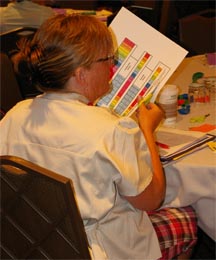from Erica K. Jacobsen, JCE High School Editor
The rush is over. No, not preparing a classroom for the onslaught of new students or tweaking curriculum. The conference rush. As I write these words, I am happy to have achieved my goal of surviving August, which included two meetings within the space of three weeks. (Cue a sigh of relief.) These recent experiences remain on my mind as I process items collected at the Fall American Chemical Society (ACS) National Meeting in Washington, DC. As such, an article that wouldn’t normally be on my radar as one to mark of interest to high school teachers caught my attention. In the table of contents for the November 2009 issue of the Journal of Chemical Education, you’ll find a  next to Mabrouk’s article. She reports on a Web-based survey of undergraduates who presented their research at Fall ACS National Meetings in 2007 and 2008. The article sparked two parallel trains of thought. One, it took me back to my first conference presentation as an undergraduate, at a Spring ACS National Meeting, after completing a summer research project. Two, it led me to reflect on my attendance at recent meetings and how high school educators might participate in these same meetings.
next to Mabrouk’s article. She reports on a Web-based survey of undergraduates who presented their research at Fall ACS National Meetings in 2007 and 2008. The article sparked two parallel trains of thought. One, it took me back to my first conference presentation as an undergraduate, at a Spring ACS National Meeting, after completing a summer research project. Two, it led me to reflect on my attendance at recent meetings and how high school educators might participate in these same meetings.
As an undergraduate, my participation mirrored that of Mabrouk’s respondents. I attended symposia, poster sessions, the exposition, and an organized social event. My participation remains similar these days, although my exposition time now naturally includes time staffing the JCE booth. Are you aware an ACS Meeting offers many events of interest to high school educators? The most widely advertised is the High School Day Program. This fall’s varied program had presentations on the upcoming National Chemistry Week periodic table theme, including a hands-on construction activity from JCE (see photo, as well as JCE’s October 2009 issue), a process-oriented, guided-inquiry learning (POGIL) experience, chocolate research (samples included!), and a demonstration show. The reduced high school teacher registration fee of $90 included the full meeting, all technical sessions, and exposition admission.
Formally organized activities are just one part of the larger conference experience. I agree with Mabrouk’s statement that “participation in informal activities is peculiarly valuable”. As an undergraduate, a loosely organized lunch for members of Alpha Chi Sigma attending the meeting resulted in an introduction to Nobel Prize winner Glenn Seaborg. My recent ACS conference had similar chance encounters. At the exposition, I met Ivan Amato, managing editor of Chemical & Engineering News. During our brief conversation, I shared my thoughts about the magazine’s conversion to digital issues. A random passerby overheard my comments and chimed in that she agreed, as well.
Future meetings will continue to offer similar opportunities. Jeffrey Hepburn, the winner of the 2010 James Bryant Conant Award in High School Chemistry Teaching, will deliver his award address at the Spring 2010 ACS National Meeting in San Francisco. The Division of Chemical Education High School Committee will continue its discussions. There will be a wide range of symposia, to join as a presenter or an attendee. As a high school educator, what are your thoughts about attending (or not) such meetings?
Activity Tester Team
Thank you to those who have responded to the call for JCE Classroom Activity testers in last month’s issue. I quickly put Dani Meyers of Colorado Academy to work; she served as a tester for this issue’s Classroom Activity. Thanks, Dani! There’s still room on the team. Interested? Contact me.
Laura’s Take on the Issue
from Laura Slocum, JCE High School Associate Editor
Many teachers really enjoy doing chemical demonstrations in their classes and other venues. I certainly fall into this category; however, in spite of this, I do not actually do very many demonstrations in my classroom. I prefer to allow my students as much time as possible to do chemistry on their own in the laboratory. There are times when I am willing to trade student laboratory time for demonstration time when the demo fits nicely into my curriculum. Allen, Anderson, and Mattson’s demonstration is one of those. I plan to insert “The Remarkable Chemistry of Potassium Dioxide(1−)” into my prelab instruction when students do a gas synthesis lab to make four gases and test the chemical properties of these gases (see the online supplement). With this one demonstration, I can show students techniques they need for the lab, discuss safety parameters, and provide further information about a new chemical. This helps me to maximize the students’ laboratory time and perform a useful demonstration.




* You can follow any responses to this entry through the RSS 2.0 feed.